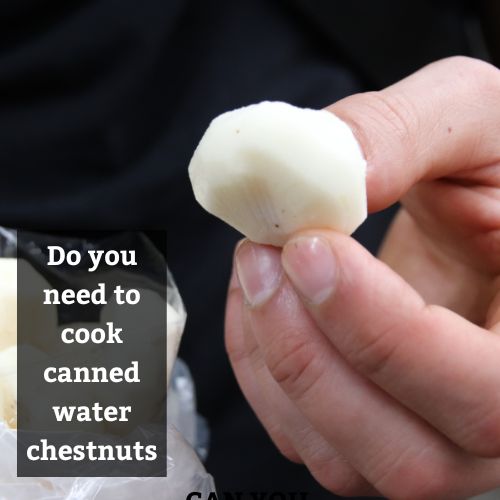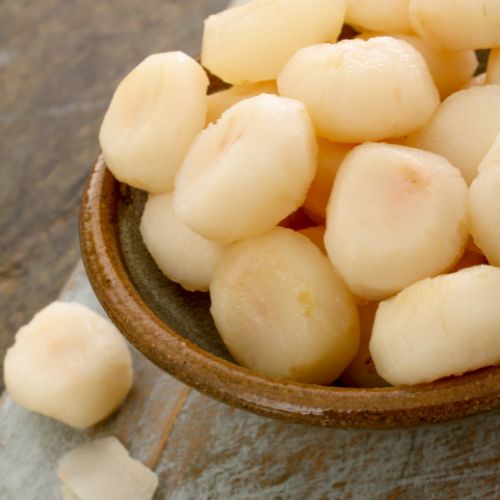Do you need to cook canned water chestnuts?
Water chestnut is an aquatic vegetable that grows in marshes, ponds, and shallow lakes. It is a type of tuber or corm with brown, papery skin and white, crunchy flesh. The flesh is shaped like a small bulb or nut, which gives it its name. Water chestnuts have a mild, slightly sweet taste and a refreshing crunch, making them a popular ingredient in many Asian cuisines. They are commonly used in stir-fries, salads, soups, and as a topping for sushi.
On the other hand, canned water chestnuts have been peeled, sliced, and packed in water and a can for preservation. They are widely available in many grocery stores and can be used instead of fresh water chestnuts in many recipes. Canned water chestnuts are convenient and have a long shelf life, but they may be softer and less crunchy than fresh water chestnuts. They are often used as a crunchy ingredient in salads, sandwiches, and stir-fries.

Do you need to cook canned water chestnuts?
You do not need to cook canned water chestnuts before consuming them. Canned water chestnuts are typically pre-cooked during the canning process, so they are ready to eat straight out of the can. However, some people prefer to rinse them under cold water before using them in recipes to remove any excess salt or preservatives.
That being said, if you plan to use canned water chestnuts in a cooked dish, such as a stir-fry, you can add them directly to the dish and they will cook through during the cooking process. They do not need to be pre-cooked separately before being added to the dish.
Can you eat water chestnuts straight from the can? Yes, you can eat water chestnuts straight from the can, as they are typically pre-cooked during the canning process and are safe to consume without further cooking. However, some people may prefer to rinse them under cold water to remove excess salt or preservatives before eating them.
What do canned water chestnuts taste like?
Canned water chestnuts have a mild, slightly sweet flavor and a crisp, crunchy texture. Some people compare the taste and texture of water chestnuts to that of a potato or a crisp apple, but with a slightly nutty and refreshing flavor.
It’s worth noting that fresh water chestnuts have a more pronounced flavor and a crunchier texture than canned water chestnuts, which can be slightly softer due to the canning process. Nonetheless, canned water chestnuts can still add a unique texture and flavor to various dishes, such as stir-fries, salads, and sandwiches.
Can you eat water chestnuts straight from the can?

Yes, you can eat water chestnuts straight from the can, as they are typically pre-cooked during the canning process and are safe to consume without further cooking. However, some people may prefer to rinse them under cold water to remove excess salt or preservatives before eating them.
It’s important to note that while canned water chestnuts are safe to eat straight from the can, they may not have the same texture and flavor as fresh water chestnuts. Fresh water chestnuts have a crisp and crunchy texture, while canned water chestnuts may be softer and have a slightly different taste. Nonetheless, canned water chestnuts can be a convenient and tasty ingredient in various dishes.
How do you eat canned water chestnuts?
Canned water chestnuts are a versatile ingredient that can be used in a variety of dishes. Here are some ways you can eat canned water chestnuts:
- In salads: Slice canned water chestnuts thinly and add them to green salads, pasta salads, or coleslaw for a satisfying crunch.
- In stir-fries: Slice canned water chestnuts and add them to your stir-fry, vegetables and meat for added texture and flavor.
- In sandwiches or wraps: Add sliced water chestnuts to your sandwich or wrap for a satisfying crunch and a unique texture.
- As a snack: Rinse canned water chestnuts under cold water and eat them as a snack on their own or with a dip.
- In Asian dishes: Water chestnuts are a common ingredient in many Asian dishes, such as spring rolls, dumplings, and soups. You can use canned water chestnuts in these recipes for convenience.
Remember that canned water chestnuts are typically pre-cooked and do not require further cooking, but you can cook them along with other ingredients in a dish if desired.
Are canned water chestnuts healthy?
Canned water chestnuts can be a healthy addition to your diet, as they are low in calories and fat and high in fiber, potassium, and vitamin B6. Here are some potential health benefits of canned water chestnuts:
- Low calories: Canned water chestnuts are low in calories, with one cup containing approximately 80 calories. This makes them a great option for people watching their calorie intake.
- High in fiber: Canned water chestnuts are a good source of dietary fiber, with one cup containing approximately 3 grams of fiber. Fiber can help promote digestive health and reduce the risk of diseases like heart disease and diabetes.
- High in potassium: Canned water chestnuts are a good source of potassium, with one cup containing approximately 362 mg. Potassium is an important mineral that helps regulate blood pressure and may reduce the risk of stroke and heart disease.
- Low fat: Canned water chestnuts are low in fat, with one cup containing less than 1 gram. This makes them a good option for people trying to limit their fat intake.
However, it’s important to note that canned water chestnuts may be higher in sodium due to the canning process. Therefore, it’s a good idea to rinse them under cold water before using them to remove any excess salt. Additionally, while canned water chestnuts are a healthy option, they should be eaten in moderation as part of a balanced diet.
What are canned water chestnuts used for?
Canned water chestnuts are a versatile ingredient that can be used in a variety of dishes. Here are some common uses of canned water chestnuts:
- Stir-fries: Canned water chestnuts are a popular ingredient in stir-fries as they add a satisfying crunch and unique texture to the dish. They can be sliced and added along with other vegetables and meat.
- Salads: Sliced canned water chestnuts can be added to green salads or pasta salads for a satisfying crunch.
- Asian dishes: Water chestnuts are commonly used in Asian dishes such as spring rolls, dumplings, and soups. Canned water chestnuts can be used in these dishes for convenience.
- Sandwiches or wraps: Sliced water chestnuts can be added to sandwiches or wraps for a satisfying crunch and unique texture.
- As a snack: Canned water chestnuts can be eaten as a snack on their own or with a dip.
- Casseroles or stuffing: Canned water chestnuts can be added to casseroles or filling for texture and flavor.
- Soups or stews: Canned water chestnuts can be added to soups or stews for texture and nutrition.
Canned water chestnuts are versatile ingredients that add unique texture and flavor to various dishes.
Can you microwave canned water chestnuts?
While it is technically possible to microwave canned water chestnuts, it is not the ideal cooking method as it can result in a soggy texture. It is generally better to cook canned water chestnuts on the stove or in the oven to help maintain their crisp texture.
However, if you need to microwave canned water chestnuts for convenience or time-saving purposes, here are some tips:
- Drain the water chestnuts and rinse them under cold water to remove any excess salt.
- Pat them dry with a paper towel to remove any excess moisture.
- Place the water chestnuts in a microwave-safe dish and cover them with a lid or microwave-safe plastic wrap.
- Microwave on high for 30-second intervals, checking and stirring until the water chestnuts are heated through.
- Use the heated water chestnuts immediately in your desired recipe.
Keep in mind that microwaving canned water chestnuts can result in a softer texture than if you were to cook them on the stove or in the oven.
How do you store opened canned water chestnuts?
If you have opened a can of water chestnuts and have some leftovers, you should store them properly to maintain their freshness and quality. Here are some tips for storing opened canned water chestnuts:
- Transfer the leftover water chestnuts to a clean, airtight container. If the can has a plastic lid, you can use it to cover the container.
- Store the container in the refrigerator. Canned water chestnuts can last several days in the fridge, but it’s best to consume them within 3-4 days for optimal freshness.
- If you have a large amount of leftover water chestnuts and don’t plan to use them within a few days, you can also freeze them. Transfer the water chestnuts to a freezer-safe container or bag, and store them in the freezer for up to 6 months.
- When you are ready to use the leftover water chestnuts, check for any signs of spoilage, such as an off smell, slimy texture, or mold growth. If you notice any of these signs, discard the water chestnuts.
Proper storage of opened canned water chestnuts can help prevent food waste and ensure you have a ready supply of this versatile ingredient for your next recipe.